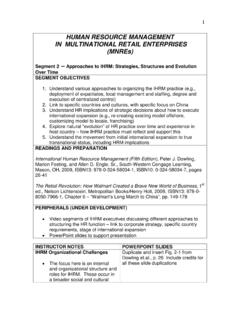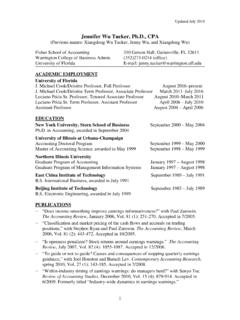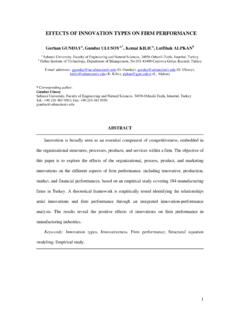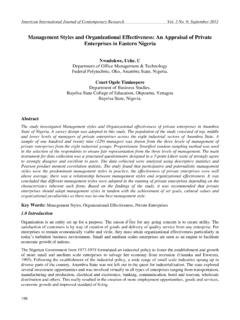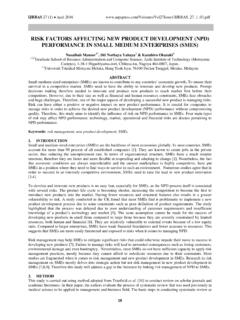Transcription of Keller-Lehmann-Brands and Branding-final
1 BRANDS AND BRANDING: RESEARCH FINDINGS AND FUTURE PRIORITIES Kevin Lane Keller Tuck School of Business Dartmouth College Hanover, NH 03755 (603) 646-0393 (o) (603) 646-1308 (f) Donald R. Lehmann Graduate School of Business Columbia University 507 Uris Hall 3022 Broadway New York, NY 10027 (212) 854-3465 (o) (212) 854-8762 (f) August 2004 Revised February 2005 Second Revision May 2005 Thanks to Kathleen Chattin from Intel Corporation and Darin Klein from Microsoft Corporation, members of the Marketing Science Institute Brands and Branding Steering Group, and participants at the Marketing Science Institute Research Generation Conference and 2004 AMA Doctoral Consortium for helpful feedback and suggestions. BRANDS AND BRANDING: RESEARCH FINDINGS AND FUTURE PRIORITIES ABSTRACT Branding has emerged as a top management priority in the last decade due to the growing realization that brands are one of the most valuable intangible assets that firms have.
2 Driven in part by this intense industry interest, academic researchers have explored a number of different brand-related topics in recent years, generating scores of papers, articles, research reports, and books. This paper identifies some of the influential work in the branding area, highlighting what has been learned from an academic perspective on important topics such as brand positioning, brand integration, brand equity measurement, brand growth, and brand management. The paper also outlines some gaps that exist in the research of branding and brand equity and formulates a series of related research questions. Choice modeling implications of the branding concept and the challenges of incorporating main and interaction effects of branding as well as the impact of competition are discussed. One sentence abstract Much research progress has been made in the study of branding, but many opportunities still exist. 3 Kevin Lane Keller is the E. B. Osborn Professor of Marketing at the Tuck School of Business at Dartmouth College.
3 Keller's academic resume includes degrees from Cornell, Duke, and Carnegie-Mellon universities, award-winning research, and faculty positions at Berkeley, Stanford, and UNC. He has served as brand confidant to marketers for some of the world's most successful brands, including Accenture, American Express, Disney, Ford, Intel, Levi Strauss, Procter & Gamble, and SAB Miller. His textbook, Strategic Brand Management, has been adopted at top business schools and leading firms around the world. With the 12th edition published in March 2005, he is also the co-author with Philip Kotler of the all-time best selling introductory marketing textbook, Marketing Management. Donald R. Lehmann is the George E. Warren Professor of Business at Columbia Business School at Columbia University. His research focuses on individual and group choice and decision making, research methodology, the adoption of innovation , and new product development. He is particularly interested in knowledge accumulation, empirical generalizations, and information use.
4 He has published more than 80 articles and books, serves on the editorial boards of several academic journals, and is the founding editor of Marketing Letters. He is a past president of the Association for Consumer Research and a trustee and former executive director of the Marketing Science Institute. BRANDS AND BRANDING: RESEARCH FINDINGS AND FUTURE PRIORITIES INTRODUCTION Brands serve several valuable functions. At their most basic level, brands serve as markers for the offerings of a firm. For customers, brands can simplify choice, promise a particular quality level, reduce risk, and/or engender trust. Brands are built on the product itself, the accompanying marketing activity, and the use (or non-use) by customers as well as others. Brands thus reflect the complete experience that customers have with products. Brands also play an important role in determining the effectiveness of marketing efforts such as advertising and channel placement. Finally, brands are an asset in the financial sense.
5 Thus, brands manifest their impact at three primary levels customer-market, product-market, and financial-market. The value accrued by these various benefits is often called brand equity. Our primary goal in this paper is to both selectively highlight relevant research on building, measuring, and managing brand equity and to identify gaps in our understanding of these topics. We put considerable emphasis on the latter and suggest numerous areas of future Five basic topics that align with the brand management decisions and tasks frequently performed by marketing executives are discussed in detail: 1) developing brand positioning, 2) integrating brand marketing; 3) assessing brand performance; 4) growing brands; and 5) strategically managing the brand. We then consider the implications of this work for choice models. Finally, we present a simple framework for integrating the customer-market, product- 1 For commentary on the state of branding, see special issues of International Journal of Research in Marketing (Barwise 1993) and Journal of Marketing Research (Shocker et al.
6 1994). For a more exhaustive review of the academic literature on brands and brand management, see Kevin Lane Keller (2002), Branding and Brand Equity, in Handbook of Marketing, eds., Bart Weitz and Robin Wensley, Sage Publications, London, 151-178. 2market, and financial-market level impact of brands and how the brand is created and developed by company actions. BRANDING DECISIONS AND TASKS DEVELOPING BRAND POSITIONING Brand positioning sets the direction of marketing activities and programs what the brand should and should not do with its marketing. Brand positioning involves establishing key brand associations in the minds of customers and other important constituents to differentiate the brand and establish (to the extent possible) competitive superiority (Keller et al. 2002). Besides the obvious issue of selecting tangible product attribute levels ( , horsepower in a car), two particularly relevant areas to positioning are the role of brand intangibles and the role of corporate images and reputation.
7 Brand Intangibles An important and relatively unique aspect of branding research is the focus on brand intangibles aspects of the brand image that do not involve physical, tangible, or concrete attributes or benefits (see Levy 1999). Brand intangibles are a common means by which marketers differentiate their brands with consumers (Park, Jaworski, and MacInnis 1986) and transcend physical products (Kotler and Keller 2006). Intangibles cover a wide range of different types of brand associations, such as actual or aspirational user imagery; purchase and consumption imagery; and history, heritage, and experiences (Keller 2001). A number of basic research questions exist concerning how brand tangibles and intangibles have their effects. Research Questions: 31. In developing brand equity, what is the role of product performance and objective or tangible attributes vs. intangible image attributes? 2. Are intangible attributes formative (causes) or reflective (constructed) reasons for equity or choice?
8 That is, are they considered a priori or constructed after experience with the brand? 3. When and to what extent does recall of pleasant images (or hot emotions) shield a brand from less positive or even negative cognitive information? 4. How much of brand equity is tied to unique attributes of a product? What happens when competitors copy these attributes? 5. Which attribute associations are most stable and beneficial to a brand over the long run ( , high quality and upscale ) and which have limited useful life ( , being hip )? 6. Can brands be thought of as simply a judgment bias or in terms of context effects in consumer decision-making? What implications do these perspectives have for brand equity measurement and valuation? Brand Personality. Aaker (1997) examined the personality attributed to brands and found they fall into five main clusters: 1) sincerity, 2) excitement, 3) competence, 4) sophistication, and 5) ruggedness. Aaker et al.
9 (2001) found that three of the five factors also applied to brands in both Japan and Spain, but that a peacefulness dimension replaced ruggedness both in Japan and Spain and a passion dimension emerged in Spain instead of competency. Aaker (1999) also found that different brand personality dimensions affected different types of people in different consumption settings. She interpreted these experimental results in terms of a "malleable self', which is composed of self-conceptions that can be made salient by a social situation (see also Graef (1996, 1997)). While Azoulay and Kapferer (2003) have challenged the conceptual validity of this particular brand personality scale, the anthromorphism of a brand is common in both casual consumer conversation ( , that brand is hip ) and advertising messages. Research Questions: 41. How does brand personality affect consumer decision-making? Under what circumstances? 2. Is brand personality of more strategic or tactical ( , in terms of the look-and-feel of ad executions) importance?
10 3. What is the value of the different personality dimensions? Are certain personality dimensions more valuable at driving preference or loyalty than others? Does the value vary by product category or by other factors? 4. How stable are these various personality dimensions and what causes them to evolve or change? How does this stability compare to the stability of other types of brand associations? Brand Relationships. Research has also explored the personal component of the relationship between a brand and its customers. Fournier (1998) examined the nature of relationships that customers have as well as want to have with companies (see also Fournier and Yao (1997) and Fournier, et al. (1998)). Fournier views brand relationship quality as multi-faceted and consisting of six dimensions beyond loyalty or commitment along which consumer-brand relationships vary: 1) self-concept connection, 2) commitment or nostalgic attachment, 3) behavioral interdependence, 4) love/passion, 5) intimacy, and 6) brand partner quality.

